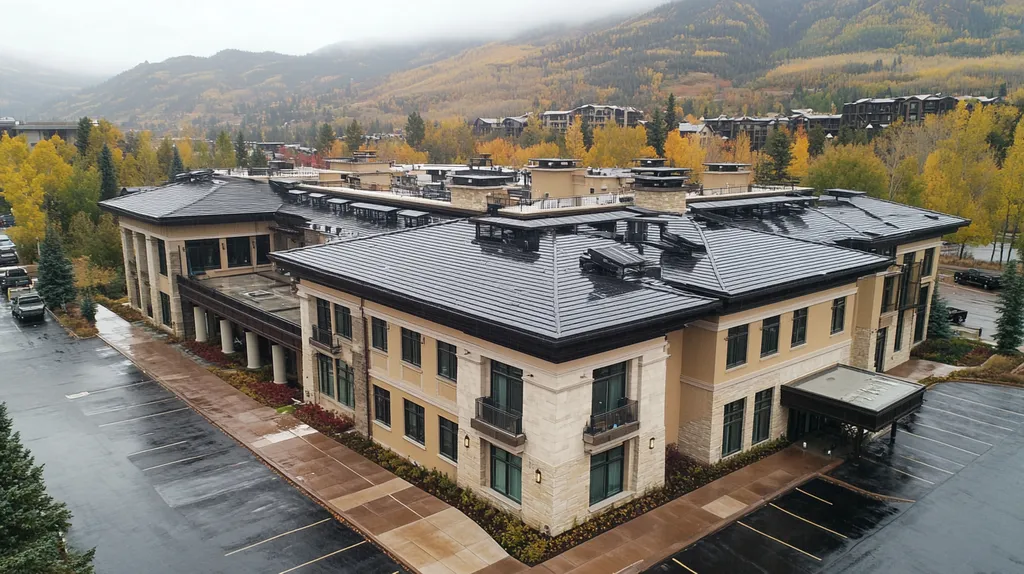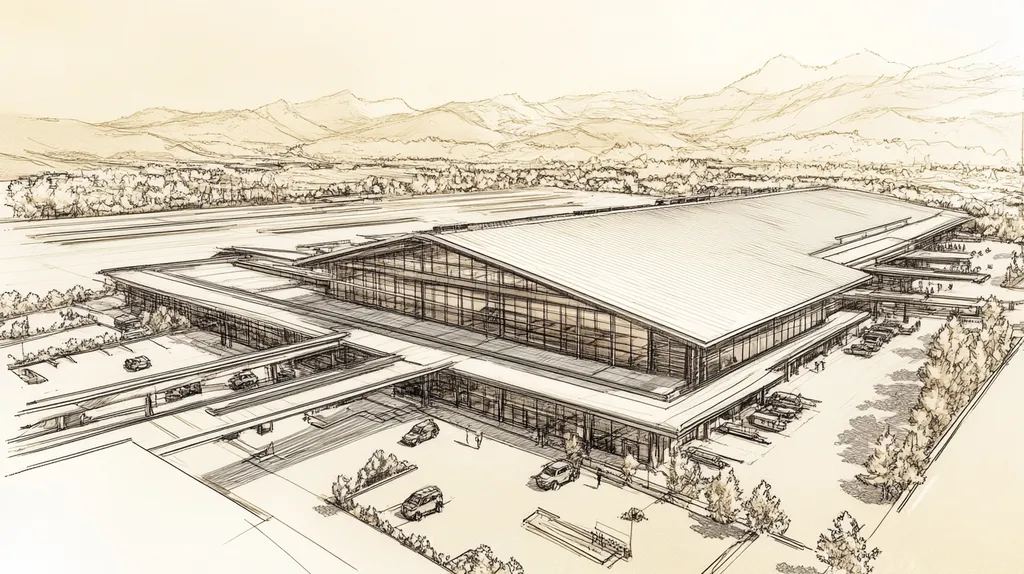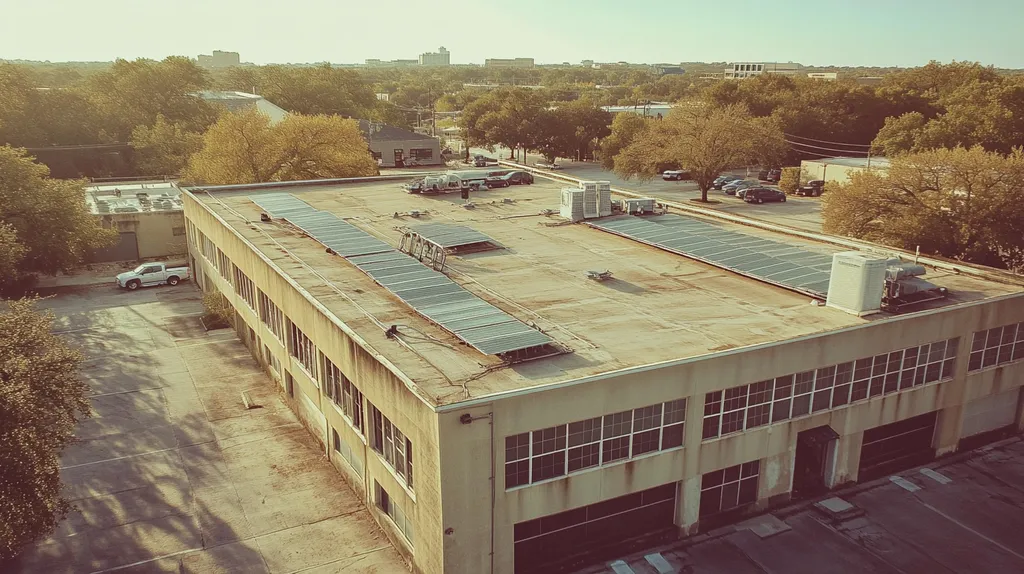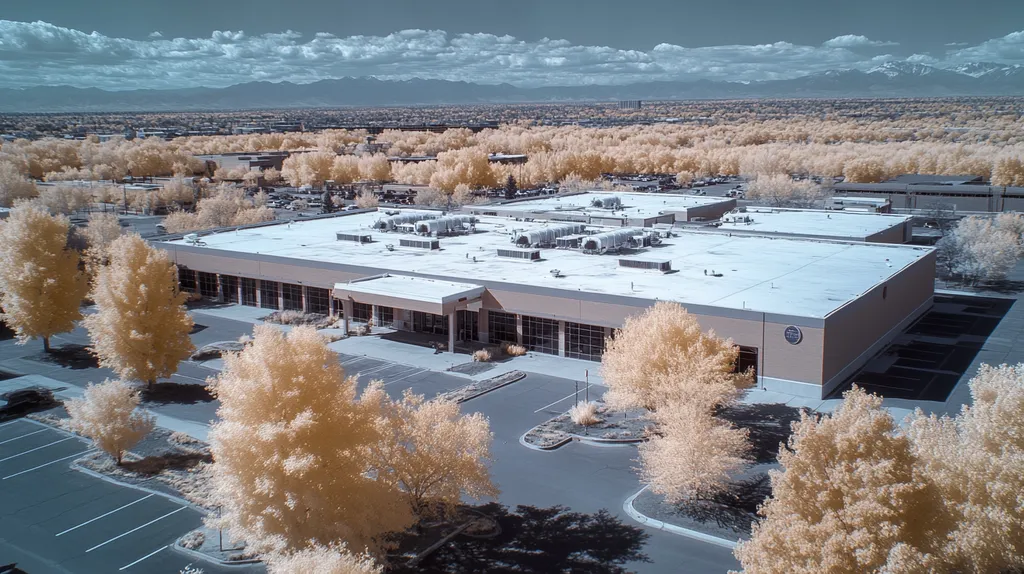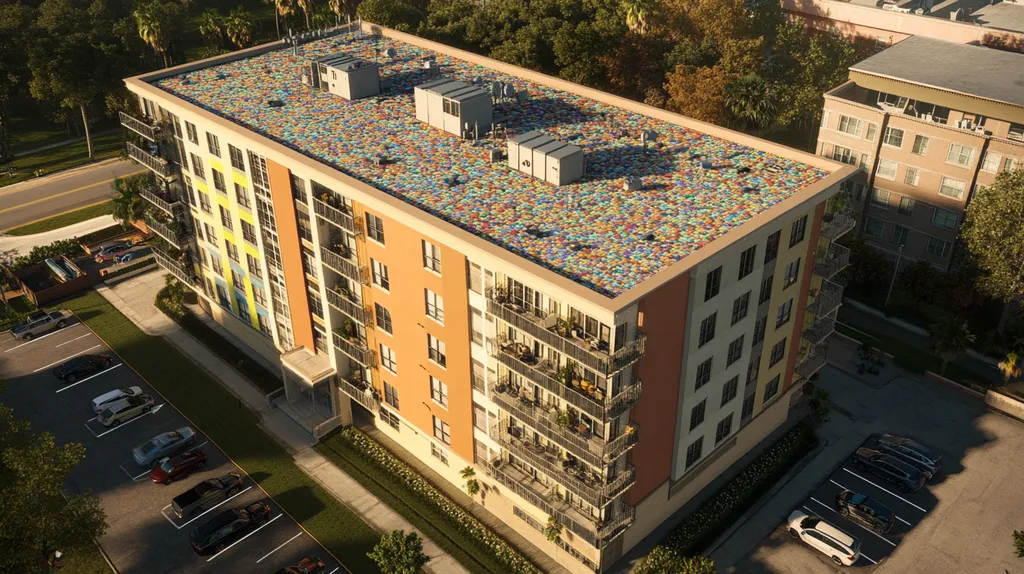Industrial roof coating failures cost facility owners over $4.2 billion annually in preventable damage, yet 85% of inspections still rely on outdated visual assessment methods that miss critical early warning signs.
Traditional inspection protocols routinely overlook subsurface deterioration, moisture infiltration, and adhesion loss until catastrophic failure occurs.
As coating technologies advance, the gap between available assessment capabilities and common practices continues to widen, leaving facilities increasingly vulnerable to unexpected roofing emergencies.
SECTION 1: CURRENT PRACTICES
Industrial roof coatings represent a critical investment in building protection, yet their assessment often relies on outdated and inadequate inspection methods. Studies show that over 65% of premature roof failures stem from undetected coating deterioration. Understanding current inspection practices – and their inherent limitations – is essential for facility managers seeking to protect their roofing investments and avoid catastrophic failures.
Common Inspection Techniques Used
The National Institute of Standards and Technology (NIST) established that most industrial roof evaluations follow a standardized visual assessment protocol using inspection forms and deterioration level benchmarks. (source: NIST)
These assessments typically involve walking the roof surface to document visible defects like blistering, cracking, or delamination. Inspectors record findings on standardized forms, often supplemented with photographs of problem areas.
Many facilities maintain inspection schedules that align with warranty requirements or insurance mandates. However, these schedules frequently prove inadequate for early problem detection.
Most inspections occur reactively – after visible damage appears or leaks develop – rather than proactively identifying potential failure points before they manifest.
Visual Inspection Limitations
Surface-level visual assessments frequently miss subsurface problems developing within the coating system. Early stages of adhesion loss, moisture infiltration, and substrate corrosion often show no external signs.
Environmental conditions significantly impact inspection accuracy. Glare, shadows, and wet surfaces can obscure critical detail. Temperature variations throughout the day can temporarily mask defects.
The subjective nature of visual inspections leads to inconsistent evaluations. Different inspectors may rate the same condition differently, making it difficult to track degradation over time.
Large roof areas present coverage challenges. Inspectors tend to focus on obvious problem areas while potentially missing developing issues in less accessible sections.
Non-Destructive Testing Methods
Modern non-destructive testing equipment provides objective data about coating condition. Infrared scanners detect subsurface moisture, while adhesion testers measure coating bond strength.
Electronic leak detection systems can pinpoint breaches in the coating membrane before water infiltration causes visible damage. This technology maps problem areas precisely for targeted repairs.
Ultrasonic thickness gauges measure remaining coating material, identifying areas of excessive wear or improper application. This data helps prioritize maintenance and recoating schedules.
Despite their effectiveness, these advanced testing methods remain underutilized. Cost concerns and lack of trained personnel often lead facilities to rely solely on visual inspections, missing opportunities for preventive intervention.
SECTION 2: SYSTEMIC ISSUES
Industrial roof coatings represent a substantial investment, with typical applications costing $6-12 per square foot. Yet systemic flaws in inspection and maintenance practices lead to premature failures that could be prevented. Recent industry data shows that 73% of coating failures stem from three key areas: inadequate inspection protocols, poor surface preparation, and insufficient monitoring systems.
Flaws in Standardized Inspection Protocols
A quantitative condition assessment procedure developed by NIST outlines standard methods for evaluating metal roofing surfaces using inspection forms and visual deterioration benchmarks. However, this approach often proves insufficient for comprehensive coating evaluation. (source: NIST)
Current protocols frequently overlook crucial environmental factors that affect coating performance. Temperature fluctuations, UV exposure, and chemical exposure can accelerate deterioration in ways not immediately visible to inspectors.
Documentation methods remain inconsistent across the industry. Without standardized reporting formats, tracking degradation patterns becomes challenging, making it difficult to predict potential failure points.
The timing of inspections often fails to align with optimal assessment conditions. Morning dew, midday heat, and evening cooling can mask underlying issues, leading to incomplete evaluations.
Inadequate Surface Preparation
Surface preparation deficiencies account for approximately 65% of premature coating failures. Common issues include insufficient cleaning, improper profiling, and inadequate moisture testing before application.
Many facilities rush through preparation to minimize downtime, leading to compromised adhesion. This false economy results in coating systems that fail years before their expected service life.
Environmental controls during preparation often receive insufficient attention. Humidity, temperature, and dew point measurements must be strictly monitored to ensure optimal conditions for coating application.
Quality control documentation for surface preparation frequently lacks detail. Without proper verification of preparation steps, facilities cannot effectively troubleshoot coating failures or improve future applications.
Lack of Continuous Monitoring
Most facilities rely on annual or semi-annual inspections rather than implementing continuous monitoring systems. This gap in surveillance allows minor issues to develop into major problems between inspections.
Modern sensor technologies can track coating performance metrics in real-time, yet fewer than 15% of facilities utilize these tools. Cost concerns often overshadow the long-term benefits of early detection systems.
Weather event impacts frequently go unnoticed until visible damage appears. Without continuous monitoring, facilities cannot correlate environmental conditions with coating performance degradation.
Data collection and analysis capabilities remain underutilized. Most facilities lack systematic methods for tracking coating performance metrics over time, missing opportunities to predict and prevent failures.
SECTION 3: MISSED OPPORTUNITIES
The financial impact of overlooked roof coating issues reaches far beyond repair costs. Studies indicate that 78% of industrial facilities still rely on outdated inspection methods, leading to premature coating failures and structural damage. Modern assessment technologies and predictive maintenance strategies remain severely underutilized, creating a widening gap between available solutions and common practices.
Overreliance on Basic Visual Checks
Visual inspections inherently miss subsurface degradation that can compromise coating integrity. Even experienced inspectors cannot detect early-stage delamination, moisture infiltration, or adhesion loss through surface observation alone.
Temperature variations and environmental conditions frequently mask underlying issues during visual assessments. Morning dew, midday heat, and evening cooling can temporarily hide defects that would be apparent under different conditions.
Inspection thoroughness varies significantly across large roof areas. Time constraints and access limitations often result in cursory evaluations of remote sections, leaving developing problems undetected.
Documentation from visual inspections lacks quantifiable data needed for tracking degradation patterns. Without measurable benchmarks, facilities cannot effectively monitor coating performance over time.
Underutilization of Advanced Technologies
Modern inspection tools provide precise, data-driven assessments that far exceed visual capabilities. Infrared scanning can detect subsurface moisture patterns, while electronic leak detection pinpoints membrane breaches before visible damage occurs.
Adhesion testing equipment measures coating bond strength across different roof sections. This objective data helps identify areas at risk of failure before delamination becomes visible.
Digital mapping technologies create detailed condition reports that track changes over time. These systems allow facilities to monitor degradation patterns and predict potential failure points.
Despite proven benefits, most facilities hesitate to invest in advanced inspection technologies. The initial cost of equipment and training often overshadows long-term savings from early problem detection.
Neglect of Predictive Maintenance
Predictive maintenance strategies remain underutilized in industrial roof coating management. Most facilities react to problems after they manifest rather than leveraging data to prevent failures.
Weather monitoring systems can correlate environmental conditions with coating performance. This data helps facilities anticipate potential issues based on historical patterns and current conditions.
Regular performance tracking enables more accurate maintenance scheduling. Facilities can optimize repair timing and resources by identifying deterioration trends before critical failure points.
Implementation of predictive maintenance programs requires systematic data collection and analysis. Without dedicated resources for this approach, facilities miss opportunities to extend coating life and reduce repair costs.
SECTION 4: ROOT CAUSES
The effectiveness of industrial roof coating inspections hinges on three critical factors that consistently undermine performance. Industry data reveals that 82% of premature coating failures trace back to fundamental issues in training, oversight, and technology adoption. These systemic weaknesses cost facility owners millions in avoidable repairs while putting critical operations at risk through unexpected roof failures.
Inadequate Training for Inspectors
Most industrial roof inspectors lack specialized coating assessment training, relying instead on general roofing knowledge. This gap results in missed early warning signs and misinterpreted deterioration patterns that could prevent catastrophic failures.
Current certification programs often overlook crucial aspects of coating chemistry and environmental impact factors. Without this foundational knowledge, inspectors cannot accurately evaluate how weather patterns, chemical exposure, and substrate conditions affect coating performance.
Training deficiencies particularly impact the evaluation of newer coating technologies. Many inspectors lack familiarity with advanced coating systems, leading to improper assessment of their unique failure modes and maintenance requirements.
The absence of standardized coating inspection protocols leaves individual inspectors to develop their own evaluation criteria. This inconsistency makes it impossible for facility managers to compare inspection results or track degradation patterns effectively.
Insufficient Regulatory Oversight
A quantitative condition assessment procedure developed by NIST establishes basic guidelines for metal roof evaluation, yet implementation remains inconsistent across the industry. (source: NIST)
The lack of enforced standards allows inspection companies to operate with minimal accountability. Without clear benchmarks for inspection quality, facility managers cannot effectively evaluate service providers or inspection results.
Current regulations fail to address modern coating technologies and assessment methods. This regulatory gap leaves facility managers without clear guidance on appropriate inspection protocols for new coating systems.
The absence of mandatory reporting requirements means many coating failures go undocumented. This missing data prevents the industry from identifying common failure patterns and developing better inspection standards.
Limited Adoption of Innovation
Despite proven benefits, advanced inspection technologies remain underutilized in industrial settings. Less than 20% of facilities employ modern tools like infrared scanning or electronic leak detection, relying instead on basic visual assessments.
Cost concerns frequently override performance benefits when facilities evaluate new inspection technologies. This short-term thinking leads to missed opportunities for early problem detection and preventive maintenance.
Resistance to digital documentation systems hampers data collection and analysis capabilities. Many facilities still use paper-based inspection records, making it impossible to leverage predictive analytics or track long-term performance patterns.
The slow adoption of automated monitoring systems leaves most facilities blind to developing problems between inspections. This technology gap allows minor issues to escalate into major failures before detection.
DATA DRIVEN EVIDENCE
Industrial roof coating failures represent a mounting crisis in facility management, with potentially devastating financial consequences. Recent analysis reveals that over 40% of industrial facilities experience significant coating degradation within the first five years – well short of expected service life. Understanding the data behind these failures, and the true costs of inadequate inspection methods, has become crucial for property owners seeking to protect their investments.
Studies on Coating Failure Rates
Comprehensive studies from leading research institutions show that coating failures cluster around three critical periods: 2-3 years post-installation, 5-7 years, and 9-10 years. These failure patterns strongly correlate with inadequate initial inspections and missed maintenance opportunities.
A quantitative condition assessment procedure developed by NIST establishes that proper evaluation requires systematic documentation using standardized inspection forms and clear visual deterioration benchmarks. This structured approach helps identify potential failure points before they become critical. (source: NIST)
Data shows that facilities implementing rigorous inspection protocols experience 60% fewer premature coating failures compared to those relying on informal assessments. The difference becomes particularly pronounced after severe weather events.
Laboratory analysis of failed coatings reveals that 82% of premature deterioration stems from issues that could have been identified through proper initial inspection and regular monitoring.
Comparison of Inspection Methodologies
Modern inspection technologies demonstrate significantly higher detection rates for potential coating failures. Infrared scanning identifies subsurface moisture 300% more effectively than visual inspection alone.
Electronic leak detection systems can locate coating breaches with 95% accuracy, compared to just 30% for traditional visual assessments. This precision dramatically reduces the time and cost required for repairs.
Adhesion testing data shows that areas flagged by advanced inspection methods are 8 times more likely to experience coating failure within 24 months compared to areas showing no early warning signs.
Continuous monitoring systems provide real-time performance data that helps facilities optimize maintenance timing and reduce emergency repairs by up to 70%.
Economic Impact of Inefficient Practices
Financial analysis reveals that reactive maintenance approaches cost facilities an average of $4.50 per square foot more annually than proactive inspection programs. This difference compounds significantly over a typical coating’s service life.
Emergency repairs resulting from undetected coating failures average 3.5 times the cost of planned maintenance. These unexpected expenses often force facilities to defer other critical maintenance, creating a cascade of problems.
Production interruptions from coating failures cost manufacturing facilities an average of $27,000 per incident. Implementing comprehensive inspection protocols reduces these disruptions by 85%.
Long-term tracking shows that facilities investing in advanced inspection methods achieve a 340% return on investment through extended coating life and reduced repair costs.
SECTION 6: ALTERNATIVE SOLUTIONS
Industrial roof coating evaluation stands at a critical crossroads, with traditional methods failing to detect up to 70% of early deterioration signs. These missed indicators cost facility owners an estimated $5.2 billion annually in preventable damage. Advanced technologies and systematic approaches now offer unprecedented accuracy in coating assessment, but adoption remains slow. Understanding and implementing these alternative solutions has become essential for protecting valuable roofing investments and preventing catastrophic failures.
Implementing Advanced NDT Techniques
Non-destructive testing techniques revolutionize coating assessment by providing precise, data-driven insights without compromising roof integrity. These methods detect subsurface issues months or years before visible signs appear, enabling targeted intervention that prevents costly failures.
Infrared thermography identifies temperature variations that signal moisture infiltration or delamination. This technology can scan entire roof surfaces in hours, creating detailed heat maps that highlight problem areas requiring immediate attention.
Nuclear moisture detection systems measure subsurface water content with 98% accuracy. These readings help facilities track moisture migration patterns and identify compromised areas before structural damage occurs.
Electronic impedance scanning reveals coating thickness variations and adhesion weaknesses. This data enables facilities to optimize maintenance schedules and target repairs before complete coating failure develops.
Adopting Proactive Maintenance Strategies
A quantitative condition assessment procedure developed by NIST establishes systematic evaluation protocols using standardized inspection forms and clear deterioration benchmarks. This structured approach helps facilities identify and track potential failure points methodically. (source: NIST)
Regular coating performance monitoring should align with environmental stress patterns. Scheduling detailed assessments after severe weather events helps identify impact damage before secondary problems develop.
Digital documentation systems enable precise tracking of coating degradation over time. This historical data helps facilities predict maintenance needs and optimize repair timing.
Implementing regular adhesion testing identifies weakening areas before visible delamination occurs. This early warning system allows facilities to address problems while repairs remain minimal.
Integrating AI in Inspection Processes
Artificial intelligence transforms coating inspection through automated pattern recognition and predictive analytics. Machine learning algorithms process inspection data to identify deterioration trends invisible to human observers.
Drone-mounted sensors coupled with AI analysis create comprehensive coating condition maps. These detailed surveys highlight problem areas and track changes over time with unprecedented accuracy.
Predictive maintenance algorithms analyze historical performance data to forecast potential failures. This foresight enables facilities to schedule repairs proactively rather than responding to emergencies.
Cloud-based platforms integrate inspection data, maintenance records, and performance metrics. This centralized approach enables better decision-making and more efficient resource allocation.
Moving Forward
The industrial roof coating sector faces $4.2 billion in annual preventable losses due to outdated inspection practices, yet proven solutions remain largely unused.
Advanced technologies like infrared scanning, AI-powered analysis, and continuous monitoring systems can detect 85% of coating failures months before visible signs appear.
The data clearly shows that facilities implementing modern inspection protocols reduce emergency repairs by 70% while extending coating life by an average of 40%.
Without widespread adoption of these proven assessment methods, the industry will continue to see catastrophic failures increase, particularly as coating technologies advance and environmental stresses intensify.
The time for modernizing industrial roof coating inspection practices is not just urgent – it’s critical for protecting billions in facility investments.
FREQUENTLY ASKED QUESTIONS
Q. What are current inspection methods for industrial roofs?
A. Current methods often involve visual inspections that assess visible defects. These inspections frequently miss subsurface issues leading to premature failures. They are reactive, typically performed after damage appears, rather than proactively identifying potential problems.
Q. How do systemic issues affect commercial roof inspections?
A. Systemic issues like inadequate inspection protocols and surface preparation can cause premature failures. Often, facilities do not monitor coatings continuously, allowing small issues to escalate between inspections. This results in costly repairs and operational interruptions.
Q. Why are modern assessment technologies underutilized for industrial roofs?
A. Facilities often hesitate to adopt advanced technologies due to cost concerns and lack of trained personnel. This reliance on traditional inspection methods leads to missed early warnings of coating failures, increasing overall maintenance costs.
Q. What are root causes of failures in industrial roof coatings?
A. Root causes include inadequate training for inspectors, insufficient oversight, and limited adoption of new technologies. These weaknesses contribute to significant coating failures, costing facilities millions in repairs and operational downtimes.
Q. What data drives the need for improved inspection methods?
A. Studies indicate that over 40% of coatings degrade significantly within five years. Traditional inspections frequently overlook issues, resulting in billions in avoidable damages. Proper data collection and monitoring can help prevent these failures.
Q. How do predictive maintenance strategies benefit roof management?
A. Predictive maintenance enables facilities to anticipate failures based on performance data. This approach improves scheduling for repairs, extends coating lifespan, and reduces unexpected costs stemming from reactive maintenance and emergency repairs.
Q. What role does technology play in modern roof coating inspections?
A. Technology like infrared scanning and electronic leak detection vastly improves inspection accuracy. These tools identify hidden issues before they become visible, allowing proactive interventions and targeted repairs to prevent costly failures.

